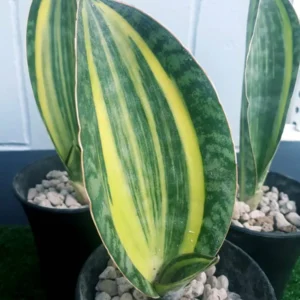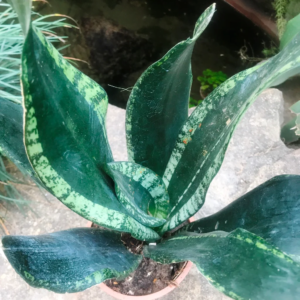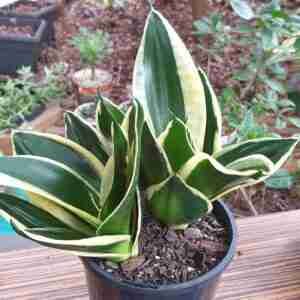Gymnocalycium mihanovichii var Friedrichii
Gymnocalycium mihanovichii var Friedrichii is a popular and striking cactus known for its distinctive form and vibrant, colorful appearance. Often seen grafted in nurseries, it is also widely recognized by the common name Moon Cactus, especially in its brightly colored cultivars. These are typically small, globular cacti from the genus Gymnocalycium, native to Paraguay and parts of Argentina.
Key Characteristics:
- Botanical Name: Gymnocalycium mihanovichii var. Friedrichii
- Common Names: Moon Cactus, Chin Cactus
- Family: Cactaceae
Appearance of Gymnocalycium mihanovichii var Friedrichii:
- Body (Stem):
- The cactus itself is typically small, about 2 to 3 inches in diameter (5 to 7 cm), and has a spherical, slightly flattened shape.
- In its natural form, it is green to purplish-brown with prominent ribs and tubercles that are smooth to the touch.
- The popular Moon Cactus varieties are often vibrant red, orange, yellow, or pink due to a genetic mutation that inhibits chlorophyll production in the plant. This mutation results in the need for the cactus to be grafted onto a green cactus species (such as Hylocereus) to survive.
- Ribs and Spines:
- The ribs are rounded, and the cactus has small, soft spines that grow from white areoles spaced along the ribs. The spines are typically short and not particularly sharp, making this species less intimidating compared to other cacti.
- Flowers:
- The Gymnocalycium mihanovichii produces beautiful, funnel-shaped flowers in shades of pale pink or white. The flowers usually emerge from the apex of the plant and bloom during the spring and summer months.
- The flowers can reach up to 1.5 inches (3-4 cm) in length, and they add a delicate beauty to the plant’s compact structure.
Growing Conditions for Gymnocalycium mihanovichii var Friedrichii:
- Light:
- These cacti prefer bright, indirect light. Direct sunlight can be too intense, especially for the colorful, grafted varieties, leading to sunburn. Indoor placement near a well-lit window or under grow lights works best.
- If grown outdoors, provide partial shade to protect the cactus from harsh midday sun.
- Soil:
- Like most cacti, Gymnocalycium mihanovichii thrives in well-draining soil. A commercial cactus mix or a blend of regular potting soil with added perlite or sand is ideal to prevent water retention.
- Watering:
- Water thoroughly when the top inch of soil is dry, allowing excess water to drain away. Avoid waterlogging, as this can lead to root rot. During the winter months, water sparingly since the cactus enters a period of dormancy.
- Temperature:
- This cactus prefers temperatures between 65-85°F (18-29°C). It does not tolerate frost and should be kept indoors or protected in cold climates.
- Minimum temperature should not fall below 50°F (10°C) to avoid damage.
- Humidity:
- Low to average humidity is best for this cactus, which is well adapted to arid environments.
Care and Maintenance of Gymnocalycium mihanovichii var Friedrichii:
- Fertilization:
- During the growing season (spring and summer), fertilize monthly with a diluted cactus or succulent fertilizer. Avoid fertilizing in the winter when the plant is dormant.
- Grafting:
- The colorful varieties of Gymnocalycium mihanovichii (Moon Cactus) are often grafted onto a rootstock like Hylocereus because they lack chlorophyll and cannot photosynthesize enough to survive on their own.
- Grafting is a simple process where the scion (the colorful Gymnocalycium) is placed onto the rootstock of a healthier cactus and secured until the tissues merge.
- Propagation:
- In its non-grafted form, Gymnocalycium mihanovichii can be propagated from seeds or offsets (pups) that form at the base of the plant. The grafted varieties, however, cannot be propagated from cuttings in the same way due to their lack of chlorophyll.
- Pests and Diseases:
- Common pests include mealybugs and spider mites. Regular inspections and treatment with neem oil or insecticidal soap can help control infestations.
- Ensure proper air circulation and avoid overwatering to prevent fungal infections or root rot.
Special Considerations for Grafted Varieties:
- Moon Cactus Varieties:
- The vibrant red, orange, or yellow colors seen in the grafted Gymnocalycium mihanovichii are due to a mutation that prevents the production of chlorophyll. While beautiful, these cacti cannot survive on their own because they rely on the rootstock for photosynthesis and nutrients.
- The rootstock (often Hylocereus or another green cactus) supports the Moon Cactus by providing energy, but over time, the grafted scion may outgrow or wear down the rootstock, requiring regrafting to ensure longevity.
Aesthetic and Ornamental Value:
- Indoor Plant: The Gymnocalycium mihanovichii var. Friedrichii is widely cultivated as an ornamental plant due to its compact size and striking colors. It makes an excellent addition to windowsill gardens, succulent arrangements, or as a focal point in small indoor plant collections.
- Low Maintenance: As a cactus, it is relatively low maintenance, requiring minimal watering and care, making it suitable for beginner gardeners or those with limited time.








Reviews
There are no reviews yet.